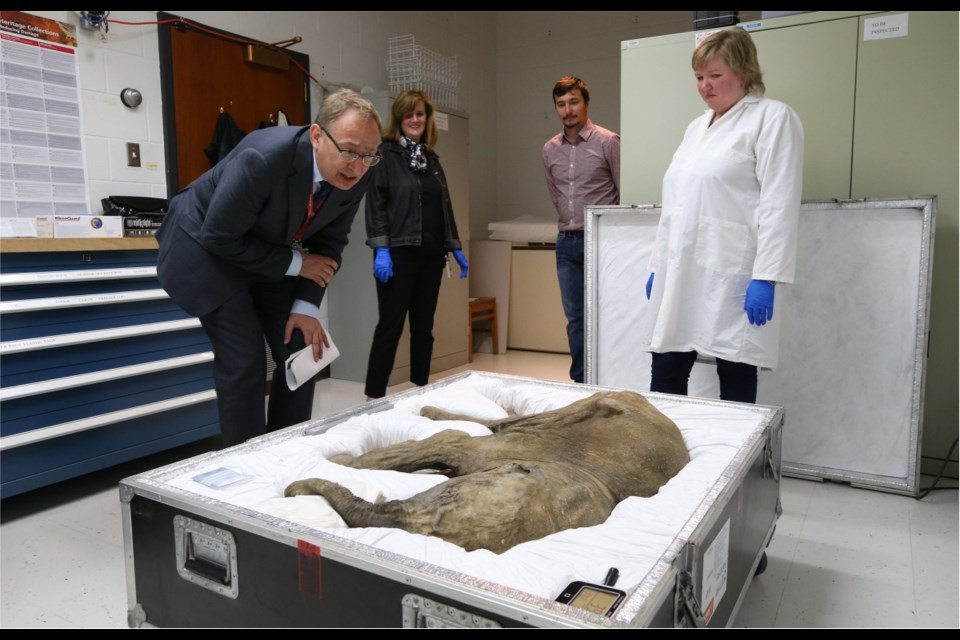The world’s only intact mammoth, a preserved baby, arrived from Russia on Friday, representing a triumph of diplomatic, scientific and personal effort by the Royal B.C. Museum.
Named Lyuba, Russian for “love,” the 40,000-year-old specimen was found frozen in Siberia in 2007. A passing reindeer herder, whose wife was also named Lyuba, made the discovery.
The mammoth, now mummified, is a permanent resident of the Shemanovskiy Yamal-Nenets District Museum in northern Siberia, Russia. Its appearance in Victoria is only the fourth time the Lyuba specimen has been outside Russia and its first appearance in Canada.
The mammoth will be a highlight of the Royal B.C. Museum’s exhibition Mammoths: Giants of the Ice Age, opening next Friday. Museum CEO Jack Lohman called its appearance a coup.
Lohman said the museum spent years convincing and reassuring Russian authorities it had the expertise and facilities to look after the Lyuba specimen. Everyone had to look past some strained political moments and develop personal relationships, museum to museum and scientist to scientist.
“When you are dealing with borders, you’ve got a lot of practical issues, hurdles, obstacles to overcome,” Lohman said.
“You are just not allowed to walk across a border carrying artwork or specimens.
“It requires relationships between museums.”
Lohman said when the museum brings in unique specimens such as Lyuba, it allows B.C. and Canadian scientists to take part in ongoing, international scientific efforts.
For example, the Royal B.C. Museum’s own specimens of fossil mammoth teeth are now part of an international investigation into formations of the mammoth molars and their correlations to the areas they were discovered and where the animals lived before death.
Lyuba has arrived with her own curator, Evgeniya Khozyainova. The Siberian minister of culture also plans to be in Victoria for the exhibit.
After the mammoth was discovered in 2007, scientists from around the world examined the find and decided the calf — it was a female — was about 30 days old when she died. She had become trapped in mud and suffocated.
The specimen weighs about 49 kilograms and is about 114 centimetres long. Its tail and one ear are missing.
Other past mammoth finds have included tusks, bones and some soft tissue found frozen. But none as complete as Lyuba have been discovered.
It’s believed the calf was preserved in lactic acid produced by a bacterium that invaded the body after death, essentially “pickling” her soft tissues.
Russian scientists have since preserved Lyuba using formalin, a process that mummified the dead animal.
It can now withstand some exposure to atmospheric temperatures and humidity.
Khozyainova said she was confident Lyuba will help make the Royal B.C. Museum’s mammoth exhibition a big success.
“Lyuba is the most unique mammoth found in the world, the only baby mammoth and the only intact mammoth,” she said through a translator.
“She is the pride of our museum.”
Mammoths: Giants of the Ice Age opens June 3 and runs to Dec. 31.
How to clone a mammoth
Cloning a new mammoth, even from an intact specimen like Lyuba, would be a tangle of scientific, technological and ethical issues, says a University of Victoria scientist.
Prof. Caren Helbing, of the UVic department of biochemistry and microbiology, said cloning any animal requires an intact nucleus from a cell.
Helbing said it’s unlikely a cell nucleus could survive thousands of years of being frozen. The only way cell nuclei can be preserved during freezing is with specific cryogenic procedures such as are used to preserve sperm or eggs.
“It would be highly unlikely to get anything from this specimen that would be clonable,” she said.
Helbing said a move more likely to succeed would be to introduce DNA segments unique to mammoths to cells of a similar living animal, such as an Asian elephant. The result would be a hybrid of the two creatures.
But she said while that may be possible, scientists are under huge ethical constraints.
“The technology is there to be able to do it,” Helbing said.
“But the question is also: ‘Even if we could, should we?’ ”



